 "dieseldub" (dieseldub)
"dieseldub" (dieseldub)
08/09/2020 at 01:13 • Filed to: None
 6
6
 3
3
 "dieseldub" (dieseldub)
"dieseldub" (dieseldub)
08/09/2020 at 01:13 • Filed to: None |  6 6
|  3 3 |
Back in November, I found a post on TDIClub of a local guy who had simply ‘had enough’ of his diesel Passat. He had done a few unexpected repairs on it and then the whole fuel system decides to crap out on him. I offered that I would better whatever the dealer offered him on trade-in. Of course for a non-running car I wouldn’t expect the offer to be any more than $1500, so I offered $2000 and he eventually accepted. More than I normally pay for a non-runner, but the car was otherwise in really nice shape and after doing the math, I figured once fixed I could still turn a small profit when I do sell it and get a nice, modern daily driver in the meantime.
Sadly, this is not uncommon for a lot of modern diesels, in particular modern ones equipped with a version of Bosch’s CP4 high pressure fuel pump.
Inside, there is a roller lifter that rides on a cam with two apexes on its single lobe. This lifter is not keyed to the bore. Everything inside the pump is lubricated only by diesel fuel itself. So, if you get fuel that has poor lubricity or worse, water contamination, you run a much higher chance of that lobe not rotating back in align with the direction the cam is moving, and when that happens, the roller gets dragged sideways across the lobe, thus shedding metal. Eventually, enough metal sheds that the pump can no longer generate adequate pressure and the engine just stops running. This metal also works its way into the injectors, into the fuel rail and the screen on the end of the pressure regulator on one end of the fuel rail, into the fuel filter housing and even all the way back to the fuel tank. When this happens, the general recommendation is ‘replace it all.’
I did most of that... I didn’t replace all the hoses and lines, but I did my best to clean them of any remaining metal by flushing them with chemical cleaners and compressed air.
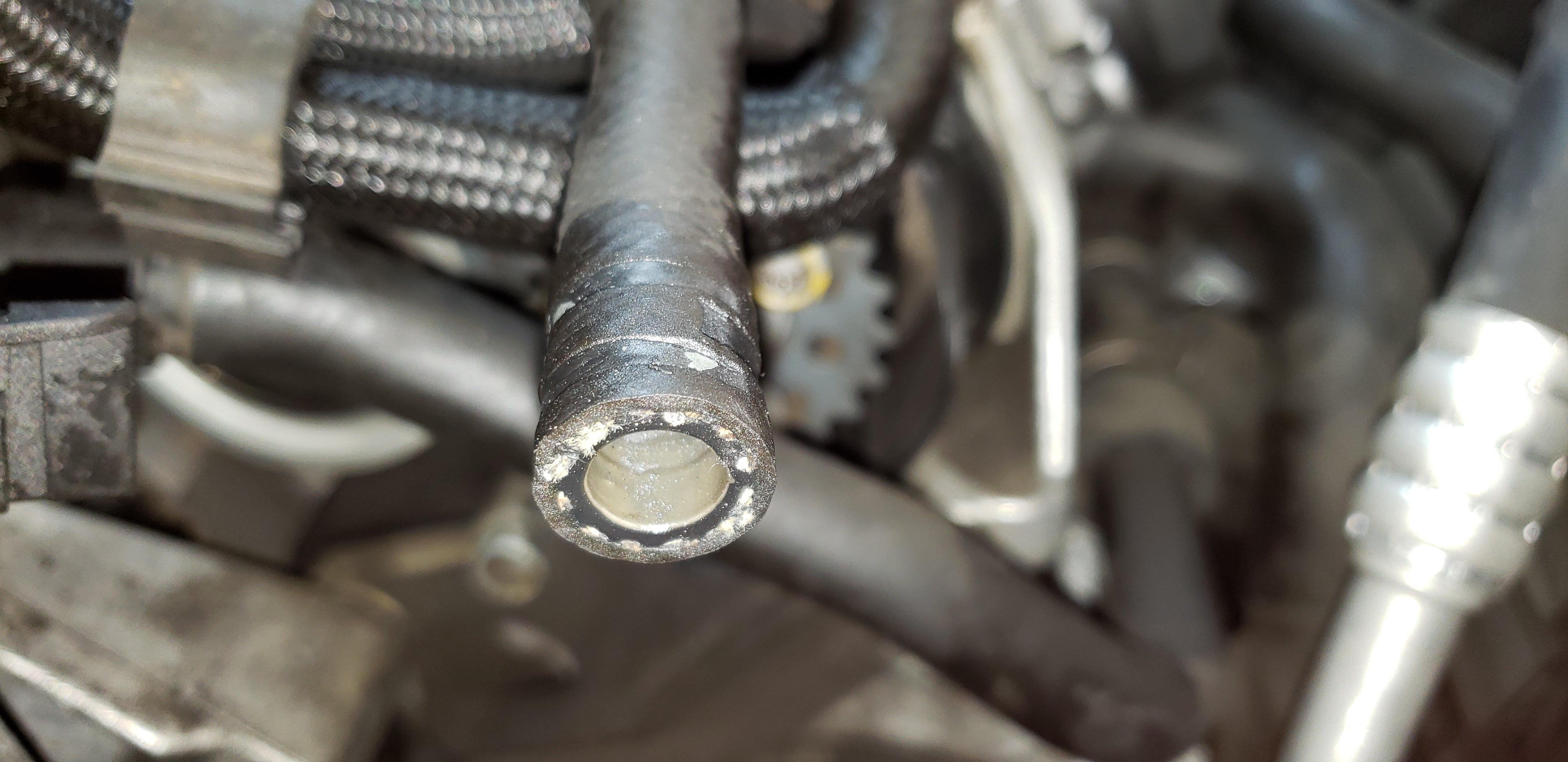
Surprisingly, the fuel metering valve on top of the high pressure fuel pump, usually the first place you check for metal debris in one of these fuel systems to confirm the failure mode, had no metal on it. The repair history the previous owner gave me seemed to indicate another shop attempted to ‘clean metal’ out of the fuel system, then wondered why it still wouldn’t start.
So, more than $2000 in parts later, I get to work. The timing belt wasn’t all that old. It had been replaced somewhere around 135,000 miles and at the time I did the work, it had 159,000. If the belt had more miles, closer to its change interval, I would have replaced it and related components as well, but since they were relatively young, I opted to leave the belt.
Parts list includes new fuel filter housing and filter, new in tank sender/fuel pump, new injectors, new fuel rail, new injector return hoses and fittings and of course, new high pressure fuel pump. All sourced from the local dealer.
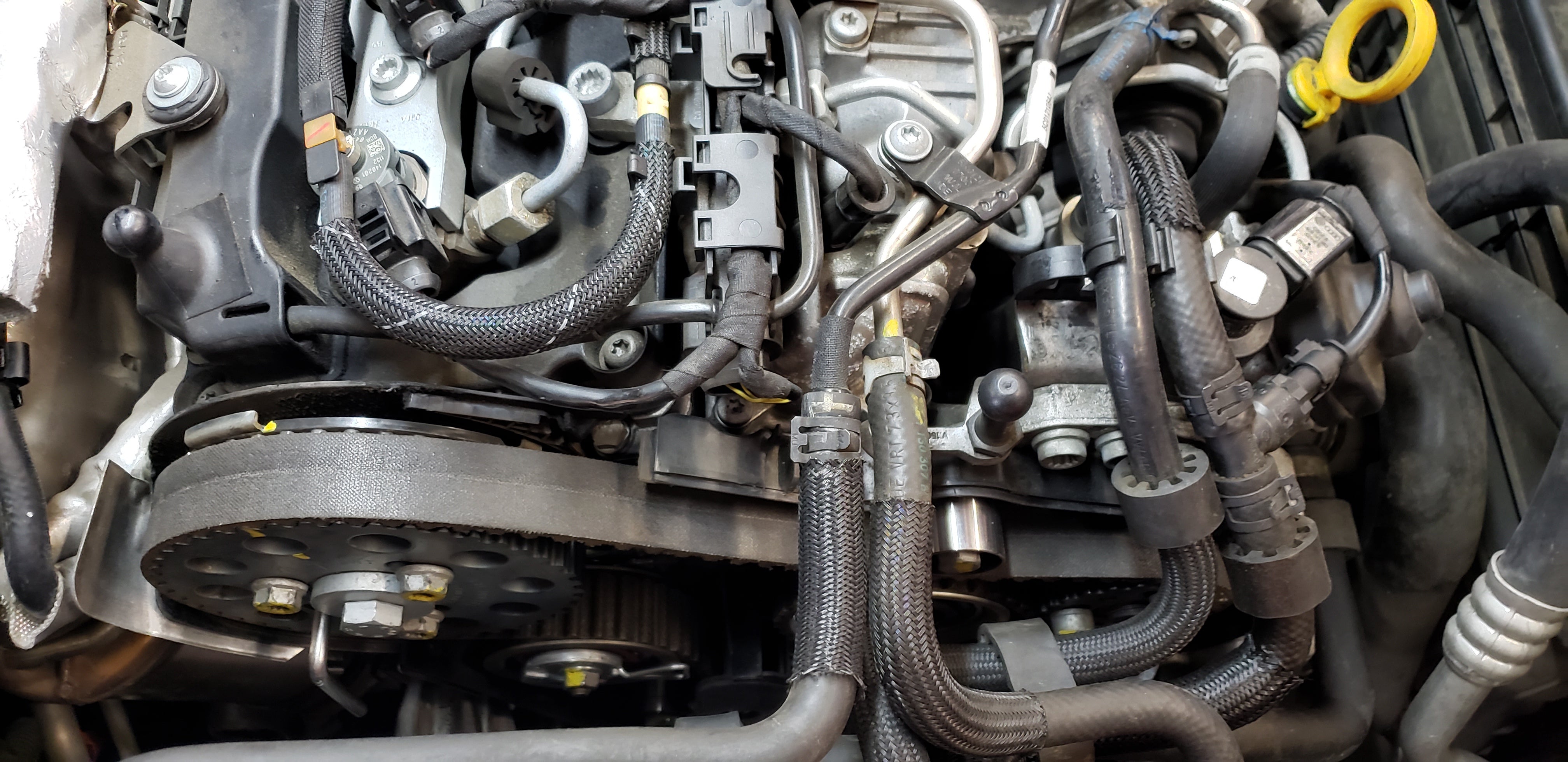
In the above photo, I was preparing to remove the belt. Already had the tensioner de-tensioned, note the extra pin stuck in the tensioner that I bent at a 90 degree angle to clear the engine mount bracket. Special procedure for further de-tensioning the belt to make removing the belt that bit easier. Also note the lock pin in the cam pulley, the cam pulley itself is adjustable. The lock pin locks the hub behind the pulley. The hub is keyed to the cam, the outer pulley that the belt directly drives is adjustable. The reason for this is because of how thick and tight the belts are on these, they came up with a somewhat unusual method of installing these belts. Once you wrap your head around the procedure, they’re not bad at all to do and you don’t really fight them. But you really have to buy all the special tools and follow the procedure as VW intended in order to make it easy and ensure everything is lined up perfect.
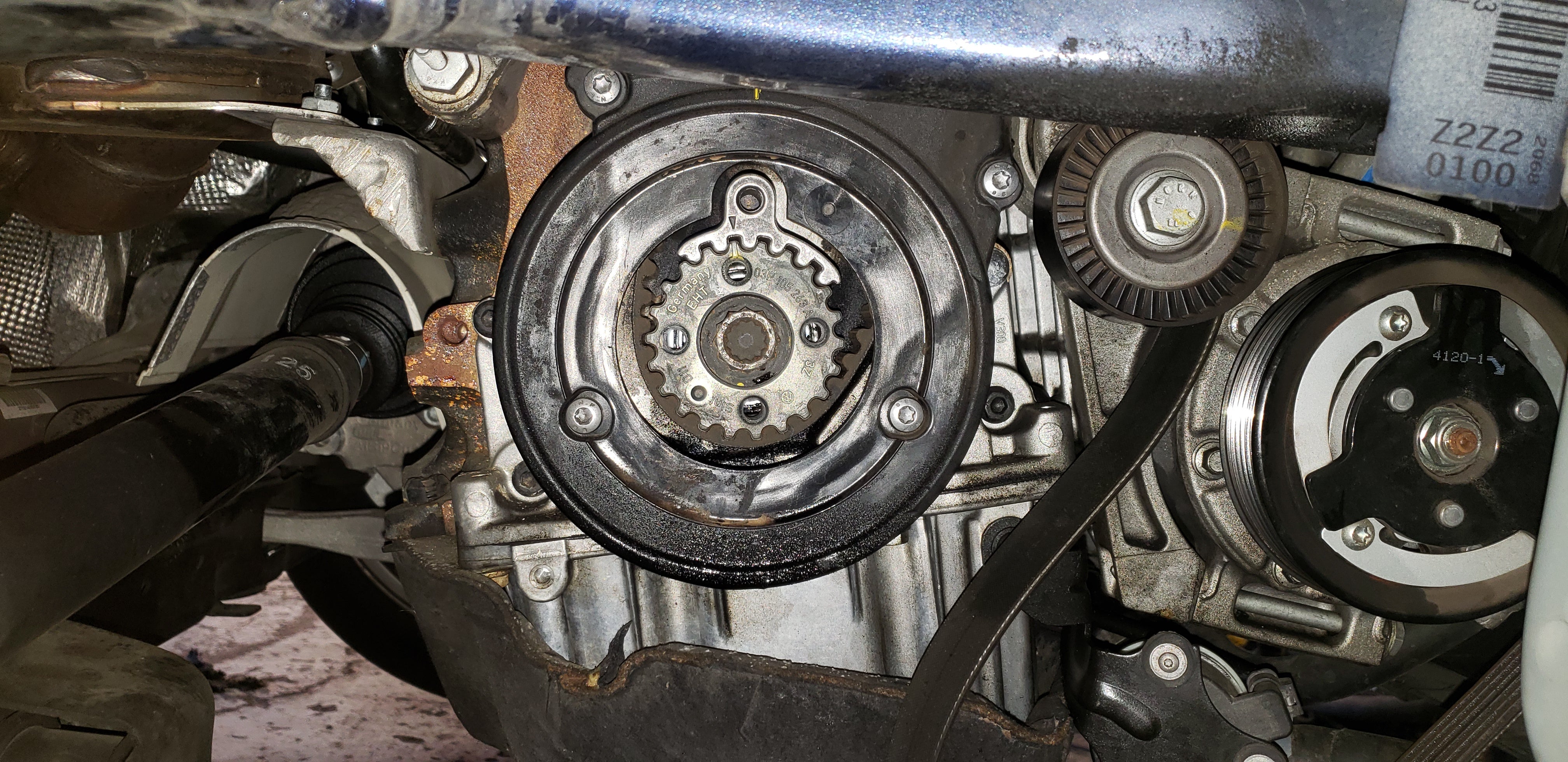
The above is a photo of the crank pulley, and the special tool used to lock it into place. Crank seal was leaking, I did take the crank sprocket off altogether, replace the seal and the bolt and reinstalled.
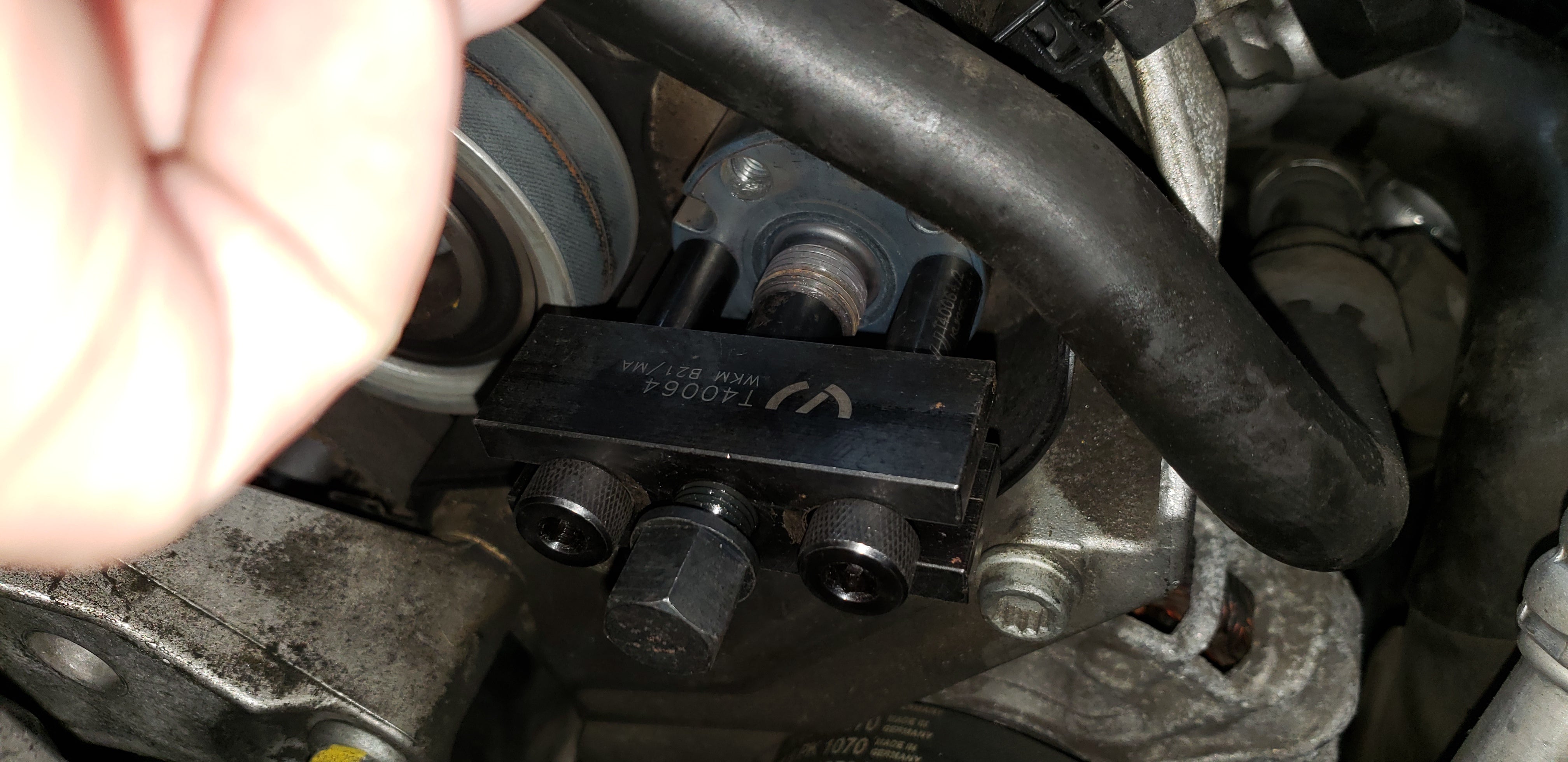
Here is a special bolt-grip puller purchased from the VW special tools program run by Snap-On to pull the sprocket off the high pressure fuel pump. A normal bolt grip puller would likely work, but given how tight of a space you’re working in, this is far faster and easier to use.
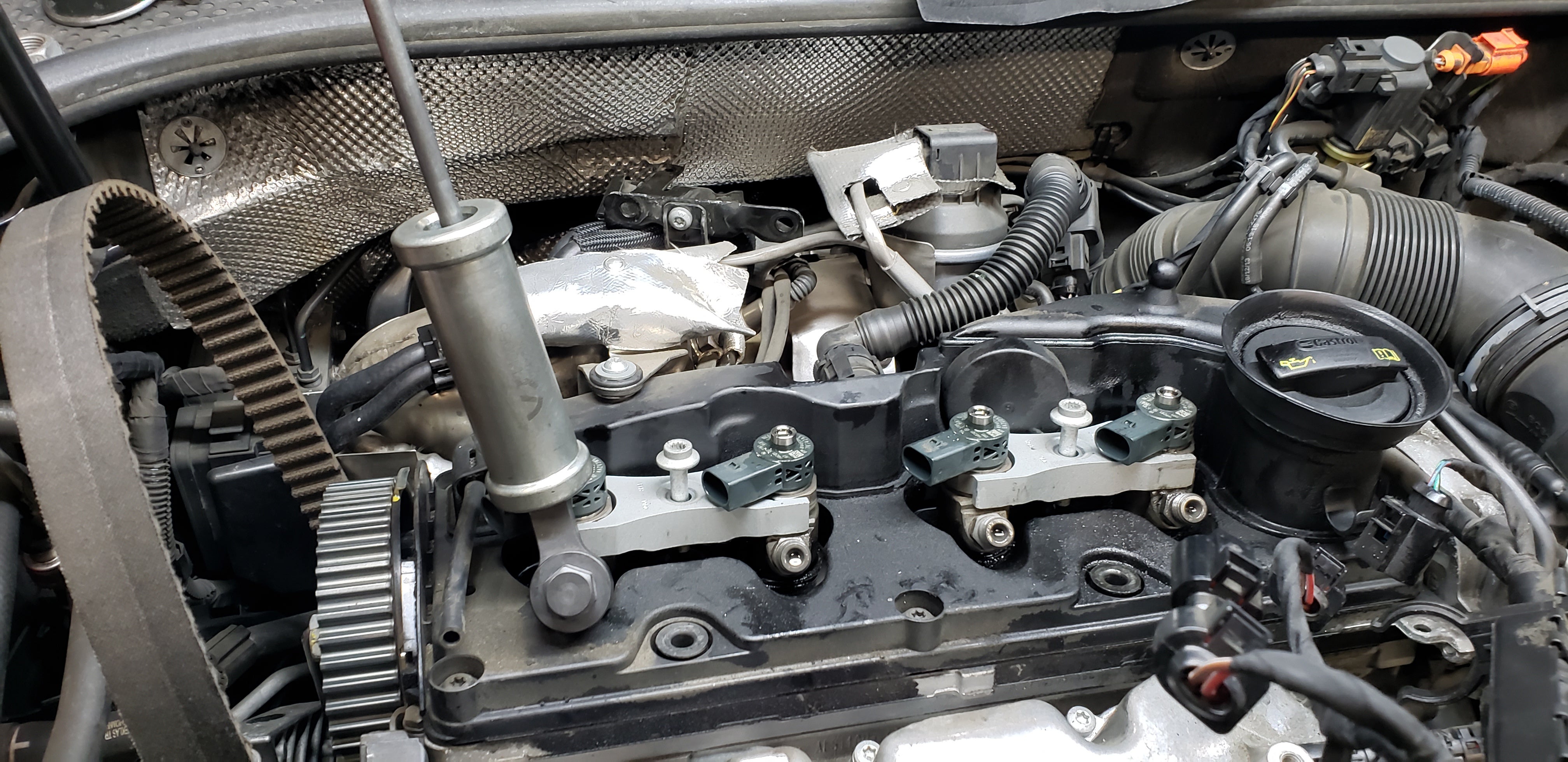
Belt removed, this is the VW slide hammer and additional special adapter I bought specifically for the solenoid style injectors with the high pressure fuel ports off to the side rather than directly on top. The injectors are removed and installed with the hold down brackets in place. One bracket for two injectors. The solenoid injectors on 4 cylinder VW TDIs in North America were only put into the ‘Gen 2' and ‘Gen 3' commonrail ‘clean diesels.’ The Gen 1 engines got piezo injectors with the fuel port on top and the electrical connector off to the side. Those I can use the same threaded adapter I do on the old rotary pump injectors VW used from 1996-2003 in the U.S.. Also, for the record, this 2014 Passat has a ‘Gen 2' engine, engine code is CKRA. The gen 3 engines are basically any of the 4 cylinder TDIs manufactured for the 2015 model year. The Gen 2/CKRA engine was found ONLY in Passats, model years 2012-14.
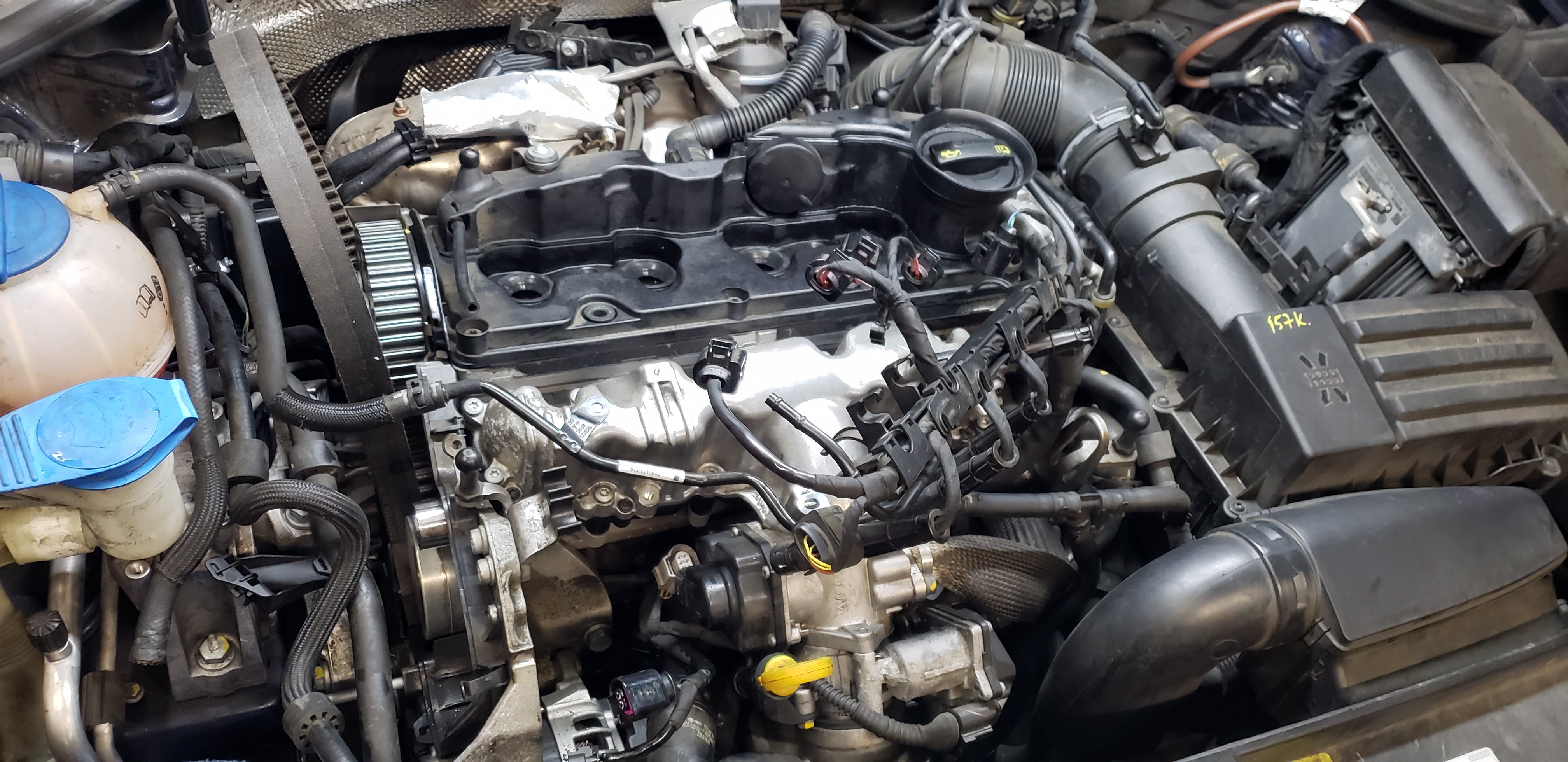
Here’s the engine with all 4 injectors out, high pressure fuel pump out as well as the fuel rail.
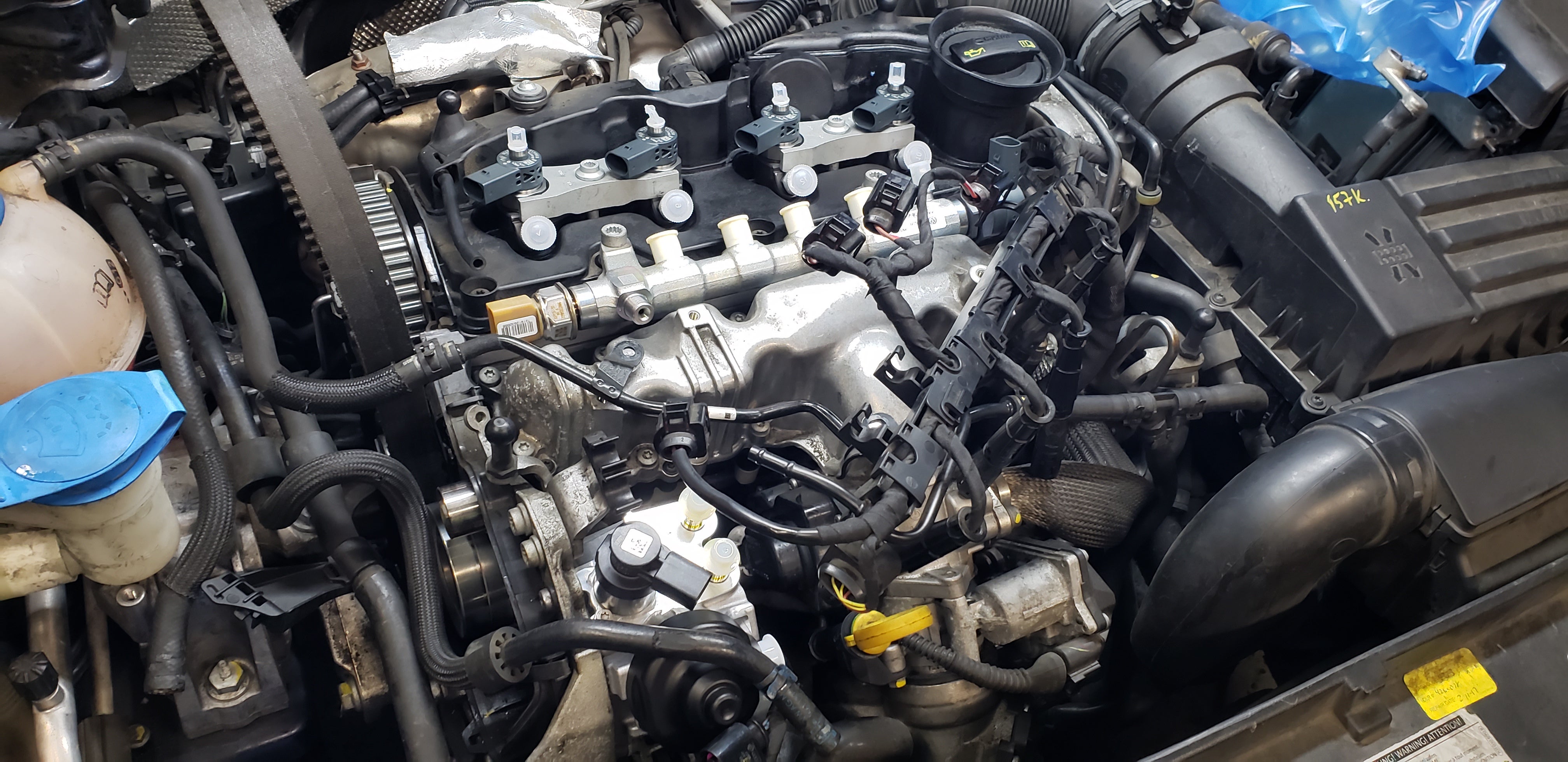
New pump, injectors and rail installed. Now to install all the fuel lines, electrical, pump sprocket hub, sprocket and timing belt, prime with fuel and get her going!
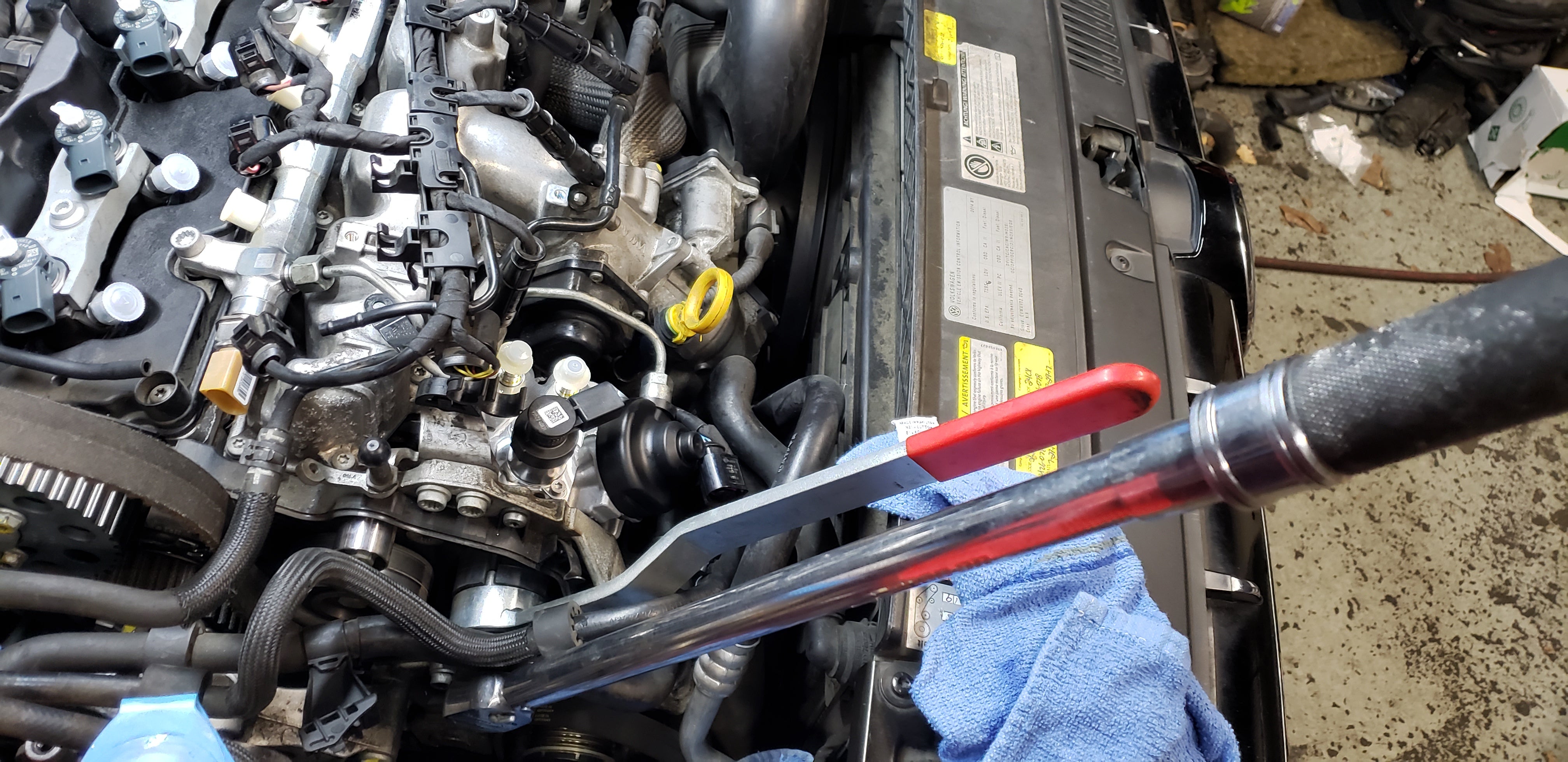
Yet another special tool just to counterhold the high pressure fuel pump’s sprocket hub while being torqued to spec. High pressure fuel line between pump and rail now installed too.
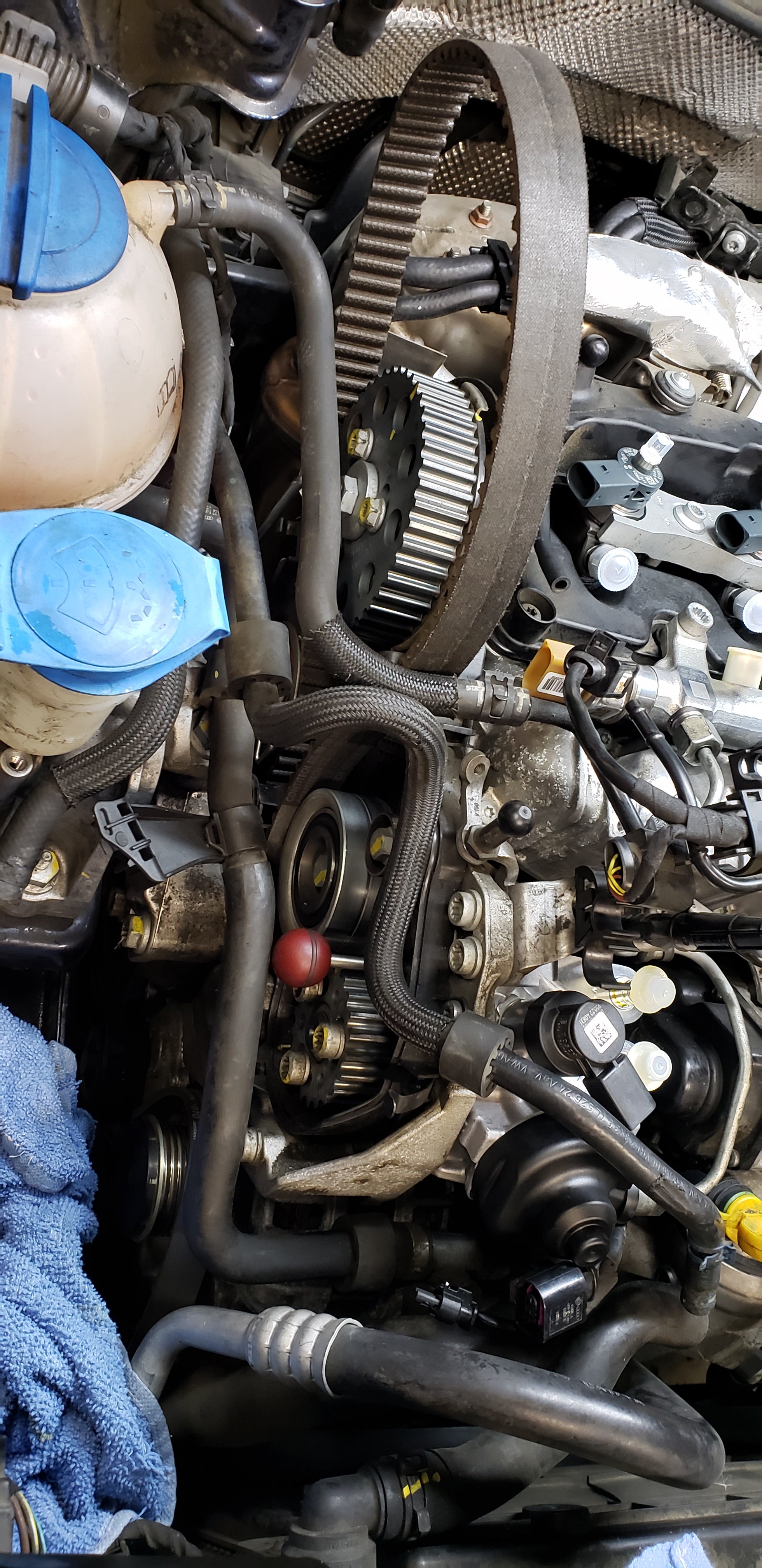
Pump sprocket back on, lock pin in place, now we’re ready to reset the belt.
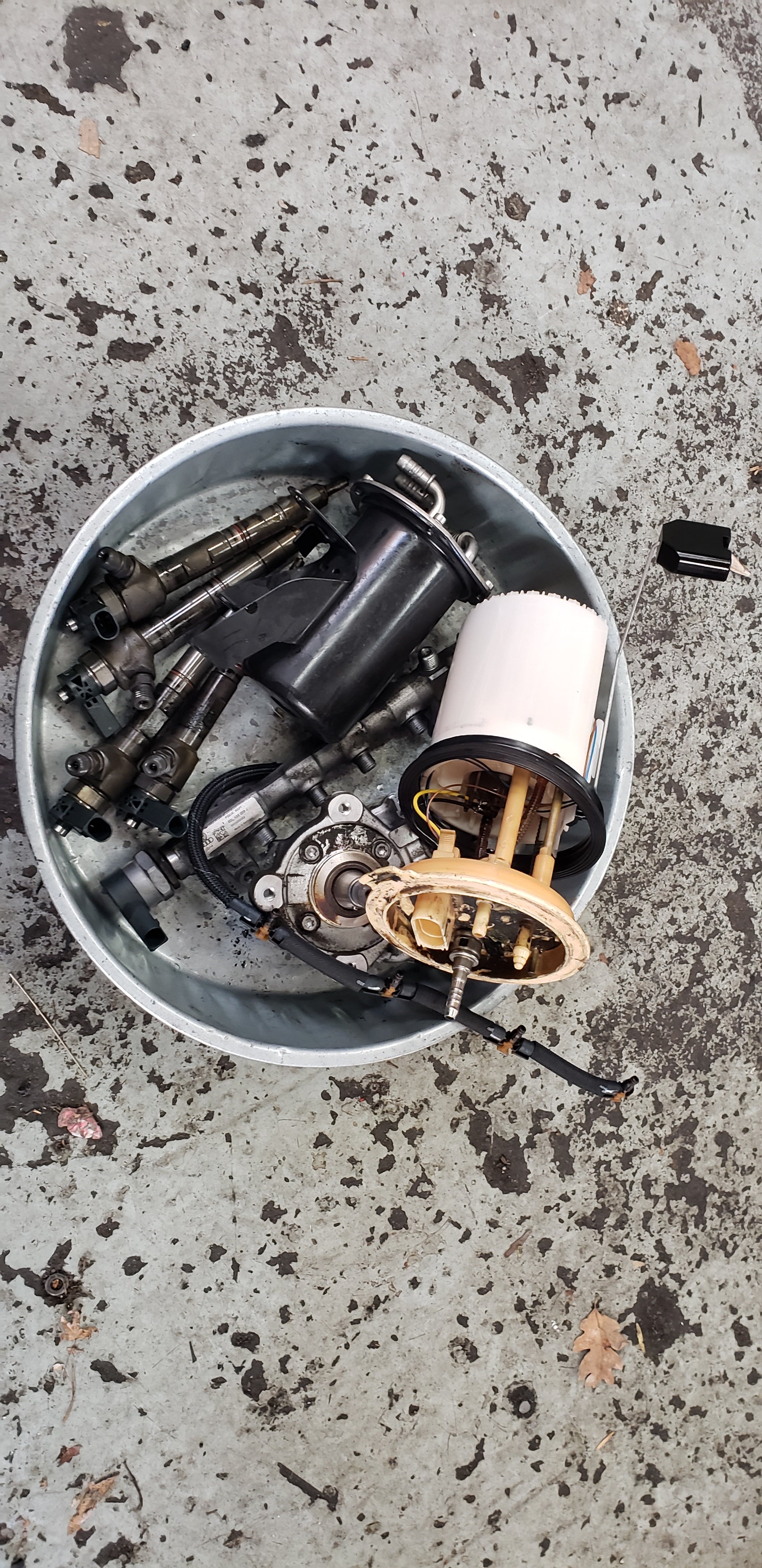
Bin of now useless, but expensive to replace parts. The high pressure fuel pump would eventually get boxed up and sent back to the dealer for a core charge. I bought a remanufactured pump, which was actually pretty reasonably priced all things considered.
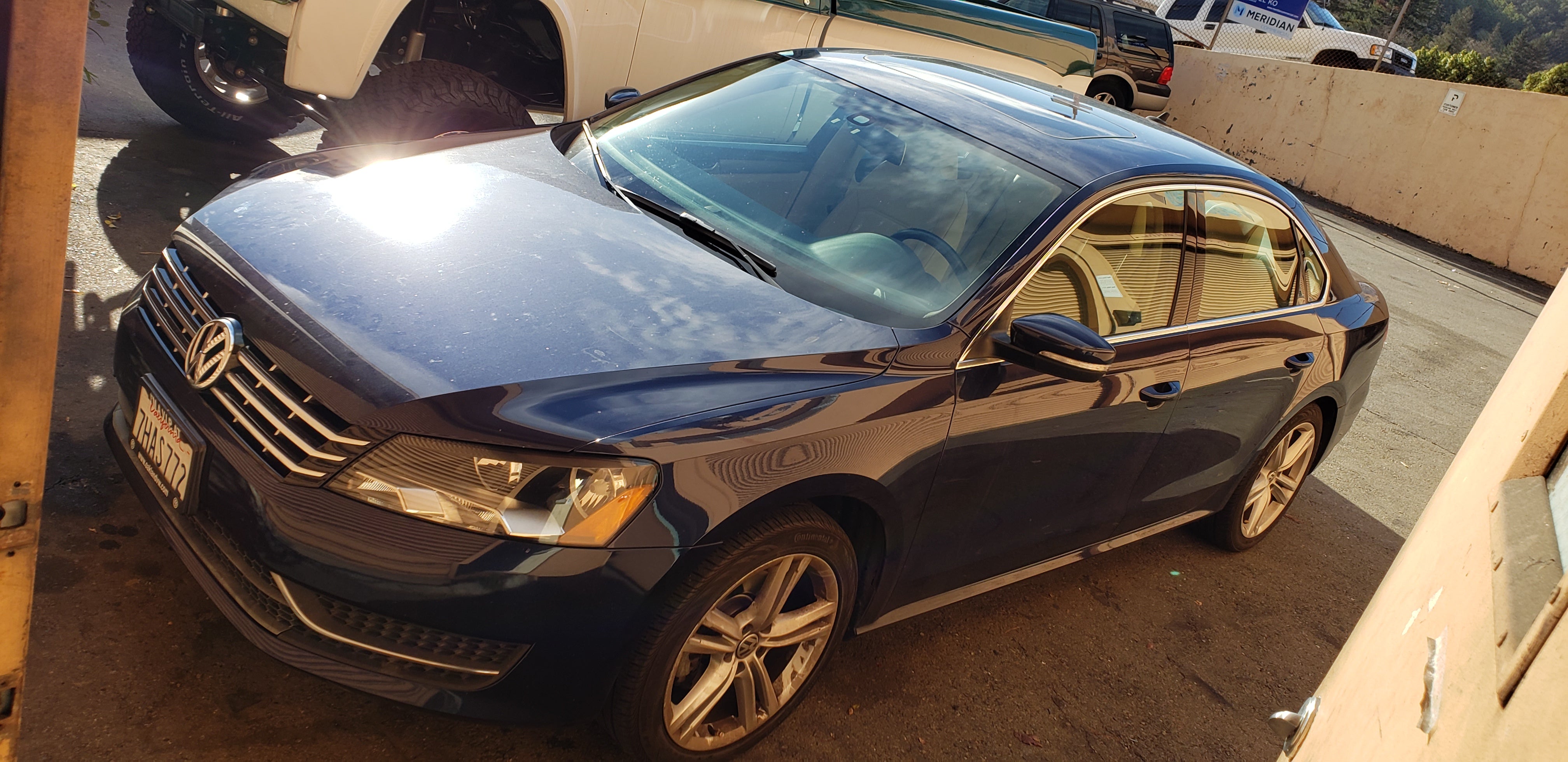
Ready to rock! Belt back on, covers reinstalled, oil changed (it was due anyway), fuel system reprimed, OH, I also forgot to mention that these commonrail injectors have a special calibration code printed on them. You have to take that calibration code and enter it into the engine computer’s adaptation channels, and be sure you get the injector order right when doing so! These injectors are that sensitive that yes, the computer needs to be told about any weird details about how each injector’s individual characteristics through a hexadecimal code.
Cleared codes, which took a bit to figure out. It kept setting back a check engine light and persistent code about not seeing ignition switched power correctly, but I went and verified that it was infact getting it... What I had to do was clear the codes 3 times in a row, key on engine off, then it finally went away. Somedays there is some weird voodoo you have to do to make modern car control modules happy... seriously... it’s kind of silly.
Car drives well, the chassis is surprisingly sprightly for the long wheelbase. Quick steering and good chassis response to inputs. The struts and shocks are a little tired, it bounces more than I’d like, but overall it’s a good feeling car. I did a transmission service a week later (DSG) and reset the clutch and basic settings while doing so. Very happy with it.
Again, this was back in December. Since then I’ve discovered it had an oil leak from what initially appeared to be an already replaced oil filter housing. I zeroed in on the brand of the housing Uroparts, and made the assumption that had to be it because virtually everything that company makes is hot garbage.
But, it turns out the worst leak was from a broken dipstick tube... It broke inside where it inserts into the engine block, impossible to see. I had to remove the dipstick tube to do the filter housing. Whoever was in there last broke it and glommed a bunch of RTV sealer on the outside of it in a poor attempt to try and keep things sealed. So, another $80 for a new tube later (on top of the near $400 for the filter housing, which has an integrated oil cooler) and we’re back on the road sans oil leaks. Hooray. That fix was actually 10,000 miles after I did the fuel system back in December. It was due for another oil change, so it was the opportune time to tackle the leak, the filter needed to be replaced anyway by then.
I’m lazy. I should have posted the initial piece on this car months ago. I get too busy at the shop and decide responding to other people’s posts is just easier and faster than making my own new ones. *shrug*
Ah well. Another car back on the road, and I have a customer of mine who borrowed it for a few days and has now decided he wants to buy it. Right on. More money to sink into the projects I mentioned !!!error: Indecipherable SUB-paragraph formatting!!!
I like the blue color on the exterior of this thing, but the tan that’s so light it’s almost white interior doesn’t jive too well with a dirty mechanic like myself. Fortunately, it’s still pretty clean. So, better sell it before I stain something up.
SE model, heated vinyl/fake leather seats, driver side is power but not memory, passenger front seat is manual adjust. RCD510 stereo is probably the nicest non-nav VW factory unit to use from the time period. Also has reverse camera, which some of the 2013 and previous models don’t. To me, this car is a bit of a sweet spot. It has the generation of TDI commonrail ‘clean diesel’ era diesel I consider to be the most likely to last long miles with the fewest issues. Makes decent power, has excellent response and on my commute the big car averages 38 MPG and will do 42+ on longer highway trips doing over 75 MPH. Could probably breach 45 MPH if I slowed down, which is pretty impressive for a big car with an automatic transmission.
I’ll miss it when it’s gone, but there’s so much more to get done and experience in other projects I have in the works. Also, my long torso doesn’t quite have adequate head room. Rumor has it other seats, like from a CC, would alleviate that for me, but I’m not going to invest that kind of time and money in a tan interior. I’d have to replace it all... not gonna happen on this especially when I didn’t think I’d be keeping it for a long time anyway.
 hillrat
> dieseldub
hillrat
> dieseldub
08/09/2020 at 07:25 |
|
No chance you live in the DC area? I would love to buy a used car from a knowledgeable mechanic like yourself.
 Turbineguy: Nom de Zoom
> dieseldub
Turbineguy: Nom de Zoom
> dieseldub
08/09/2020 at 10:27 |
|
Great read. My last TDI was a 2012 Passat and thought the car was a good balance of room, power and economy. I only traded it because my new job shortened my commute from 45 minutes to 5 and the engine barely getting up to operating temps before shutdown meant a big increase in regen cycles (and the DPF filling up that much faster, or so I thought ).
 dieseldub
> hillrat
dieseldub
> hillrat
08/09/2020 at 12:16 |
|
Nope, Bay Area California. But the friends I bought the Touareg V10 from live in NoVA in a DC suburb. I actually saw them about a month ago as they were visiting the West coast, drove their Tesla Model 3 coast to coast and back again.